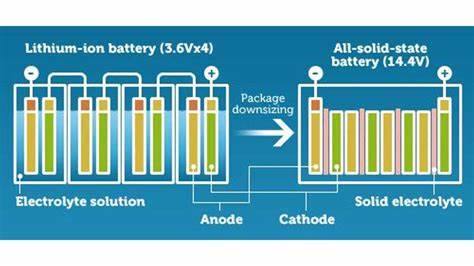
Advancements in Battery Technology: Exploring the Future of Energy Storage
Introduction
Advancements in battery technology have revolutionized various industries, from consumer electronics to renewable energy. As the demand for portable power and sustainable energy solutions continues to grow, it is crucial to understand the latest developments in this field. This article will delve into the exciting world of battery technology, exploring its historical background, key concepts, and the main discussion points that shape its future.
Historical Background
Battery technology has come a long way since its inception. Invented in the late 18th century by Alessandro Volta, the first battery, known as the Voltaic Pile, consisted of alternating zinc and copper discs separated by cardboard soaked in saltwater. This breakthrough marked the beginning of an era defined by advancements in energy storage.
Over the years, key milestones have shaped battery technology. The introduction of lead-acid batteries in the mid-19th century revolutionized the automotive industry, allowing for the widespread adoption of electric vehicles. Subsequent inventions, such as the nickel-cadmium and nickel-metal hydride batteries, further expanded the possibilities of portable power.
Key Concepts and Definitions
To fully comprehend advancements in battery technology, it is essential to define important terms and concepts. Battery chemistries refer to the different types of chemical compounds used in batteries, such as lithium-ion, nickel-cadmium, and lead-acid. Understanding their advantages and disadvantages is crucial in determining their applicability to various devices and industries.
Battery operation and functionality are based on basic principles. A battery consists of two electrodes, an anode (negative) and a cathode (positive), immersed in an electrolyte. During discharge, a chemical reaction occurs between the anode and cathode, generating an electric current. Rechargeable batteries allow for the reversal of this reaction, enabling the storage and reuse of energy.

Main Discussion Points
Introduction of new battery chemistries
In the quest for more efficient and sustainable energy storage solutions, researchers have introduced various battery chemistries. Lithium-ion batteries, widely used in smartphones and laptops, offer high energy density and long cycle life. However, they are prone to thermal runaway and have limited availability of lithium resources.
Other emerging battery chemistries, such as solid-state batteries and lithium-sulfur batteries, show promise in addressing these limitations. Solid-state batteries offer increased safety and potential for higher energy density, while lithium-sulfur batteries offer a higher theoretical energy density. Exploring the advantages and potential impact of these new chemistries is crucial in shaping the future of battery technology.
Improvements in battery capacity and energy density
Advancements in battery technology have focused on increasing the amount of energy that can be stored in a battery, leading to improvements in capacity and energy density. This has significant implications for electric vehicles and renewable energy storage. High-capacity batteries enable longer driving ranges for electric vehicles, reducing range anxiety and promoting their widespread adoption.
Moreover, improved energy density allows for more efficient storage of renewable energy, enabling a smoother transition to a greener future. Battery storage systems integrated with solar or wind farms can store excess energy during periods of low demand and release it during peak hours, ensuring a reliable and sustainable power supply.
Enhancement in battery charging and discharging speed
The demand for faster charging and discharging of batteries has driven the development of various technologies and techniques. Quick charging solutions, such as fast-charging stations and advanced charging algorithms, have been introduced to address the need for reduced charging times.

However, fast charging comes with its own challenges and limitations. It can lead to increased battery degradation and reduced lifespan, requiring careful balance between charging speed and battery health. Nevertheless, rapid charging holds great potential in industries such as transportation, where quick refueling is crucial for efficient operations.
Case Studies or Examples
Real-world examples showcase the practical applications of advancements in battery technology. Tesla, a leading electric vehicle manufacturer, has successfully implemented advanced battery systems in their vehicles, revolutionizing the automotive industry. Their battery technologies have increased the range of electric vehicles and accelerated the transition to sustainable transportation.
In the renewable energy sector, the Hornsdale Power Reserve in South Australia, featuring Tesla’s lithium-ion battery technology, has become the world’s largest lithium-ion battery energy storage system. It provides grid stability, mitigates the intermittency of renewable energy sources, and ensures a reliable supply of electricity to the region.
Current Trends or Developments
The field of battery technology is constantly evolving, with recent trends focusing on sustainability, efficiency, and safety. Researchers are exploring alternative materials and manufacturing processes to reduce the environmental impact of battery production. Additionally, breakthrough discoveries, such as solid-state electrolytes and silicon anodes, hold the potential to revolutionize battery performance.
The implications of these trends are vast, with advancements in battery technology expected to reshape various industries. From electric vehicles to grid-scale energy storage, batteries will play a crucial role in achieving a sustainable and clean energy future.
Challenges or Controversies
While advancements in battery technology offer immense potential, they also face challenges and controversies. Cost is a significant barrier to widespread adoption, with advanced battery technologies often being expensive to produce. Additionally, concerns over safety, such as the risk of thermal runaway in lithium-ion batteries, have raised questions about their long-term viability.

Controversies surrounding certain battery technologies, such as lithium-ion batteries, stem from their reliance on limited resources and potential environmental impact. Proper recycling and disposal methods are essential to mitigate these concerns and ensure the sustainable development of battery technology.
Future Outlook
Looking ahead, the future of battery technology holds exciting possibilities. Continued research and development efforts are expected to yield breakthroughs in energy storage capacity, safety, and sustainability. As battery costs continue to decline and new chemistries emerge, applications in industries such as aerospace, healthcare, and telecommunications are likely to expand.
Battery technology will play a crucial role in achieving a sustainable and clean energy future. From powering electric vehicles to supporting renewable energy grids, advancements in this field will shape our ability to transition to a low-carbon society.
Conclusion
Advancements in battery technology have transformed the way we live and paved the way for a greener future. From the introduction of new battery chemistries to improvements in capacity and charging speed, the field is characterized by innovation and progress. It is essential to recognize the significance of these advancements and support further research and development in battery technology to unlock its full potential.
References
“Advancements in Battery Technology: A Review.” Journal of Energy Storage, vol. 30, 2020, p. 101505.
Goodenough, John B., and Kyu-Sung Park. “The Li-ion Rechargeable Battery: A Perspective.” Journal of the American Chemical Society, vol. 135, no. 4, 2013, pp. 1167-1176.
Armand, Michel, and Jean-Marie Tarascon. “Building Better Batteries.” Nature, vol. 451, no. 7179, 2008, pp. 652-657.
Sakti, Apurba, et al. “Advancements in Battery Technologies for Electric Vehicles.” Chemical Reviews, vol. 120, no. 1, 2020, pp. 640-663.




